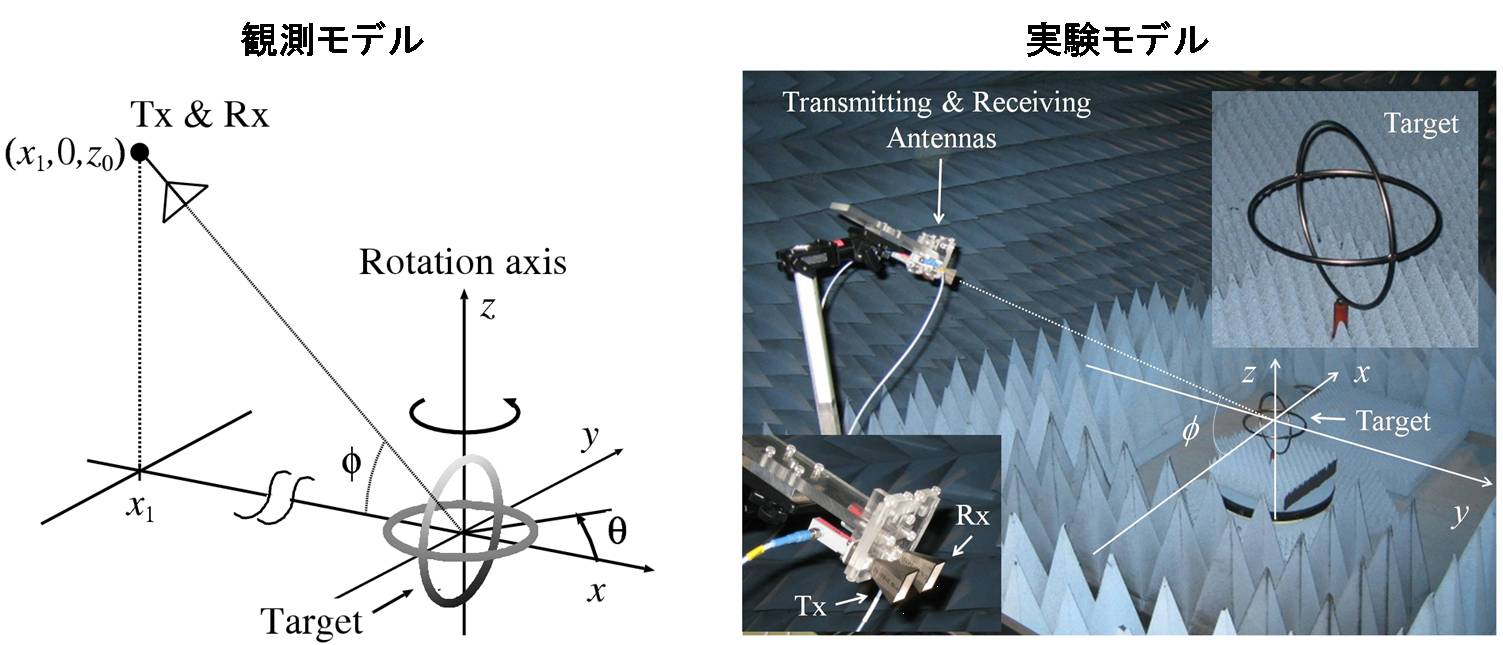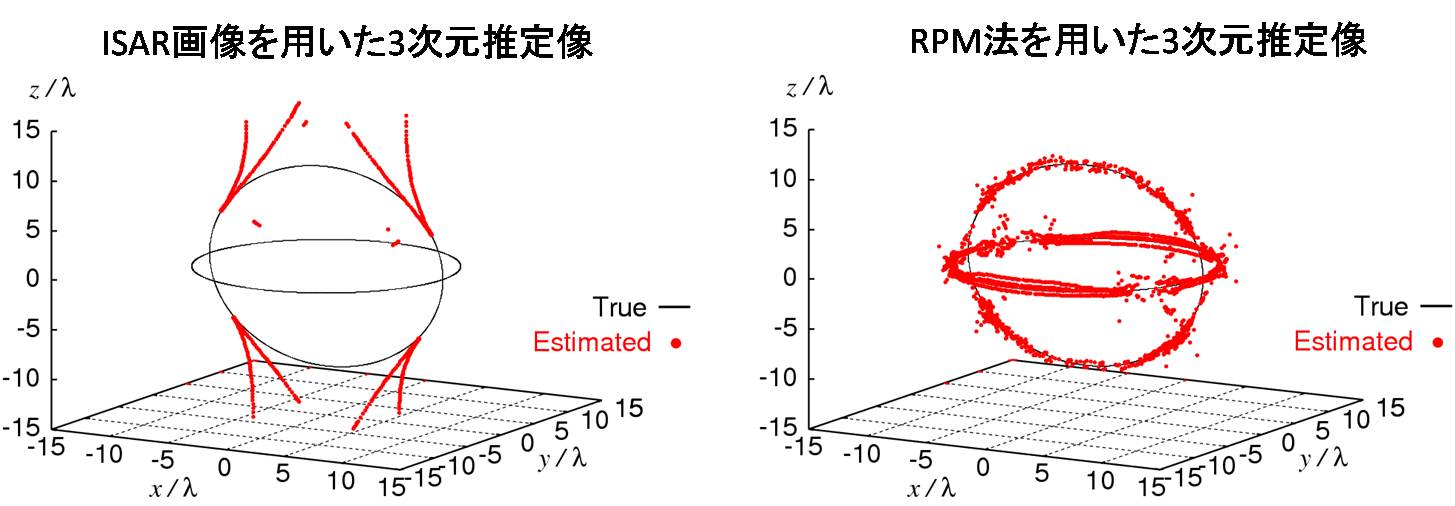Application to Stereoscopic Image Reconstruction with Airborne and Satellite Onboard Radar
Research Background and Objectives
Normal image radar is a radar that takes a two-dimensional image of a target. Recently, however, image radar that reconstructs a three-dimensional image of a target by measuring the height information of the target in various ways has been studied. Such radar is called three-dimensional image radar, and it usually extracts height information by using phase information contained in the received signal. 3D imaging using inverse synthetic aperture radar (ISAR) and its problems One of the most useful radar imaging methods is Synthetic Aperture Radar (SAR). In this method, the antenna changes its position to measure the target, and the received signals from various angles are combined to obtain an image of the target. Inverse SAR (ISAR), on the other hand, uses the moving target to produce an image. This technique is used for ship surveillance radar, etc., because it can obtain images of moving targets, especially ships and vehicles, even if the antennas are fixed. In 3D shape estimation, the target points in the ISAR image are tracked, and by using appropriate transformations, the 3D position coordinates of the target can be reconstructed. Figure 1 shows the observation model, and the right side shows an experiment in an anechoic chamber. The left side of Figure 2 is an ISAR image obtained at each observation angle, showing that the 2D position of the point changes with the angle. By properly tracking the points, we can obtain a 3D estimated image as shown in the right side of Figure 2. 3D imaging using the RPM method However, methods based on ISAR images assume that the target is a collection of points. In reality, the target surface is a continuum, and such an assumption does not hold, making tracking on the image difficult and significantly degrading 3D positional accuracy. To avoid this problem, the Range Points Migration (RPM) method recently developed in the laboratory is extended to the model as shown in Figure 3. The left side of Figure 3 is based on ISAR image tracking, in which the center of scattering continuously moves across the target surface, making point tracking difficult and degrading the estimation accuracy. In contrast, the RPM method shown on the right side of the figure can accurately estimate the 3D shape and position of a target with a continuous shape, such as a wire. We are further developing imaging technology with higher accuracy and resolution by using array antenna models and polarization information.



Shouhei Kidera, Hiroyuki Yamada and Tetsuo Kirimoto,
"Accurate 3-Dimensional Image Reconstruction Algorithm Extending RPM Method to ISAR Model",
Asia-Pacific International Conference on Synthetic Aperture Radar (APSAR) 2011, Seoul, Korea, 26-30th, Sep., 2011.
Normal image radar is a radar that takes a two-dimensional image of a target. Recently, however, image radar that reconstructs a three-dimensional image of a target by measuring the height information of the target in various ways has been studied. Such radar is called three-dimensional image radar, and it usually extracts height information by using phase information contained in the received signal. 3D imaging using inverse synthetic aperture radar (ISAR) and its problems One of the most useful radar imaging methods is Synthetic Aperture Radar (SAR). In this method, the antenna changes its position to measure the target, and the received signals from various angles are combined to obtain an image of the target. Inverse SAR (ISAR), on the other hand, uses the moving target to produce an image. This technique is used for ship surveillance radar, etc., because it can obtain images of moving targets, especially ships and vehicles, even if the antennas are fixed. In 3D shape estimation, the target points in the ISAR image are tracked, and by using appropriate transformations, the 3D position coordinates of the target can be reconstructed. Figure 1 shows the observation model, and the right side shows an experiment in an anechoic chamber. The left side of Figure 2 is an ISAR image obtained at each observation angle, showing that the 2D position of the point changes with the angle. By properly tracking the points, we can obtain a 3D estimated image as shown in the right side of Figure 2. 3D imaging using the RPM method However, methods based on ISAR images assume that the target is a collection of points. In reality, the target surface is a continuum, and such an assumption does not hold, making tracking on the image difficult and significantly degrading 3D positional accuracy. To avoid this problem, the Range Points Migration (RPM) method recently developed in the laboratory is extended to the model as shown in Figure 3. The left side of Figure 3 is based on ISAR image tracking, in which the center of scattering continuously moves across the target surface, making point tracking difficult and degrading the estimation accuracy. In contrast, the RPM method shown on the right side of the figure can accurately estimate the 3D shape and position of a target with a continuous shape, such as a wire. We are further developing imaging technology with higher accuracy and resolution by using array antenna models and polarization information.
Figure 1: Left: Observation model, Right: Experimental scene

Figure 2: Left: Example of ISAR image (point target), Right: Example of 3D imaging estimation (ISAR)

Figure 3: Left: 3D estimated image by ISAR, Right: 3D estimated image by RPM

References
"Accurate 3-Dimensional Image Reconstruction Algorithm Extending RPM Method to ISAR Model",
Asia-Pacific International Conference on Synthetic Aperture Radar (APSAR) 2011, Seoul, Korea, 26-30th, Sep., 2011.
